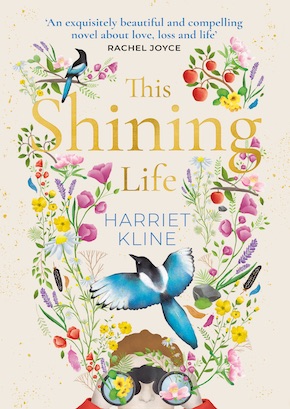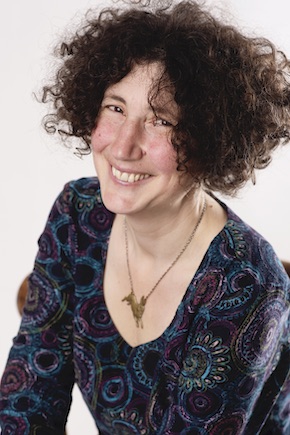Grief and transformation
by Harriet Kline
“This beautiful book shows us that grief is not a problem to solve, but an expression of love.” Ann Napolitano
My debut novel This Shining Life is a meditation on grief. It follows a family on their journey through bereavement after the death of Rich, a beloved father, son, husband and friend. When I first invented his character I saw him in a garden at dawn with the sky pale and peachy behind him. He was always associated in my mind with that colour, a shade so soft that it’s almost indistinguishable from white. I wasn’t sure why, at first. I thought it might have something to do with impermanence; this colour would always fade, just as I knew that Rich’s life force would fade from the lives his loved ones. As I started to explore the themes of love and loss in the story, it would take on greater significance. I would even argue that I couldn’t have written about grief without it. Whenever I lost direction, or needed a reminder of what I wanted to say, I would return to that colour. I tried to fill my mind with it before continuing to write.
The idea behind This Shining Life came to me after I’d lost a friend to cancer. I witnessed his death and it was an immense and humbling experience. I have never felt so sad and yet, at the same time, so whole and authentic. Standing at his feet watching the colour in his face recede, I could not hide from the awful truth of what was happening. I had to accept each moment as it unfolded. This connection with the present, this intense focus on simply being there, brought with it not only sorrow but a sense that I was utterly alive.
Afterwards I felt transformed. I remember, three days after his death, I went out to play table tennis with my family. This was usually a trial for me because my hand-eye co-ordination is lousy. But that day, I returned each serve effortlessly – even with some grace. I remember laughing at this. I had not expected to find anything funny or joyful at this time but there I was, giggling away and discovering for the first time the simple pleasure of responding to the parabola of a ball. There was a flow and an intensity to life that I had never experienced before and I was certain that grief was the catalyst. I had allowed myself to be present with the reality of his death, with the pain and the horror of each moment, and now I could be present with the joy and the love that those moments might also contain.
When I first embarked on This Shining Life I wanted to write about this. But I also wanted to write about the loss of it. My transformation only lasted a few weeks. That marvellous flow, both physical and emotional, soon got knotted up with my usual angst. I lost sight of my grief as more habitual worries resurfaced. At the funeral I read a poem but I did not truly connect it with the love of my friend; I was too focused on giving a perfect performance. The authenticity was gone. It felt like a betrayal of the grief and the man who had inspired it.
No one grieves in a vacuum, we all bring our own emotional history to it. We might search for that purity of feeling and for the transformation that comes with it, but we are so tangled up in our own problems that it is often out of reach.”
I found it easiest to write about this aspect of the experience, the loss and the disconnection, because this was how I had lived most of my life. I recognised it in other people too. No one grieves in a vacuum, we all bring our own emotional history to it. We might search for that purity of feeling and for the transformation that comes with it, but we are so tangled up in our own problems that it is often out of reach. This was why I chose to write a multi-voiced narrative; I wanted to show that there are many ways to hold back from the full extent of our feelings. Each person who had loved Rich would be blocked in some way: his wife would be hampered by depression, his mother-in-law by denial, his son by the impossible task of understanding the grief. This excavation into the means by which grief was not experienced felt like a true expression of my own bereavement journey; I had felt something authentic and then I lost it.
But what of Rich? He was the character who was most intimate with death and I wanted him to represent the flow and the wonder that came with accepting this terrible reality. The trouble was, by the time I came to write his scenes, I had lost touch with this feeling. Put me at the end of a ping-pong table at this point and I would have missed every ball. How then would I depict something that I had only glimpsed? The answer lay in the colour of the sky, which had been with him in my mind all along. I realised that this colour faded, not only because Rich would fade from the lives of everyone else, but also because that pure experience of presence can never last for long. For Rich it ended with his life. For the rest of us, it fades as our ordinary lives go on.
And yet these pale, peachy skies return at the dawn and dusk of every clear day. It is a cliché to say that the sun will always go on rising, but perhaps our response to the subtle, transient beauty can be more profound. For me, the pain of grief brought with it the promise of transformation as I was forced to accept the full extent of my emotions. With the sorrow came a sense of awe, and this colour in the sky would act as a reminder. I came to understand this when I wrote the scene where Rich stands in the garden at dawn. A line came to me: There was gold somewhere, he thought, and he was standing in the glow of it. I realised that the particular quality of that colour lies in its radiance. What we are seeing is not the gold itself, but the evidence that it is there; I could not maintain the level of presence I had experienced at the deathbed of my friend, but the awe that rode in with it still radiated through my life. I will be happy it also radiates in some way through This Shining Life.
 Harriet Kline works part-time registering births, deaths and marriages and writes for the rest of the week. Her story ‘Ghost’ won the Hissac Short Story Competition and ‘Chest of Drawers’ won The London Magazine Short Story Competition. Other short stories have been published online with Litro, For Books’ Sake and ShortStorySunday, and on BBC Radio 4. She lives in Bristol with her partner and two teenage sons. This Shining Life, her debut novel, is published by Doubleday/Transworld Digital in hardback, eBook and audio download.
Harriet Kline works part-time registering births, deaths and marriages and writes for the rest of the week. Her story ‘Ghost’ won the Hissac Short Story Competition and ‘Chest of Drawers’ won The London Magazine Short Story Competition. Other short stories have been published online with Litro, For Books’ Sake and ShortStorySunday, and on BBC Radio 4. She lives in Bristol with her partner and two teenage sons. This Shining Life, her debut novel, is published by Doubleday/Transworld Digital in hardback, eBook and audio download.
Read more
harrietkline.com
@HareandHarriet
@DoubledayUK
Author portrait © Jeni Nott Photography
Read an extract from This Shining Life

